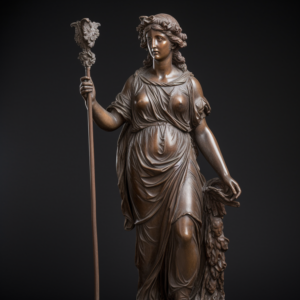Ceres is the Roman goddess of Agriculture. In ancient Roman mythology, Ceres oversaw agricultural food production, especially that of grain. Ceres is often portrayed in draping robes and holding a scepter or a basket filled with various fruits and flowers. She wears a garland constructed of ripe ears of corn, and has beautiful blonde or blondish brown hair.
Origins
The origins of Ceres come from the cultures around Ancient Rome, including the Greek culture that was absorbed by the Romans after they came into contact with each other. The name Ceres comes from the English and French words for cereal, which reflect her role as the goddess of agriculture.
The origin story of Ceres is one of the best known and dates back to the earliest incarnations of the gods of Roe. Saturn had overthrown his father, Caelus the Titan, when Saturn carried Ops and she fell pregnant. Along with the pregnancy of Ops, came a prophecy that stated that Saturn would be usurped by one of his children after they were born.
Ops gave birth to six children. Not knowing which of the six children would cause him problems in the future, Saturn ate the first five of his children after they were born. The goddess Ceres was among those five eaten by Saturn. Ceres and her siblings were saved by Ops when she tricked Saturn into swallowing a rock instead of the sixth child. Saturn was unable to digest the rock and vomited the contents of his stomach, including the newborn Ceres and her siblings.
Appearance
The appearance of Ceres is more complicated than the aesthetic of other goddesses of the Roman period of history. Ceres is a young woman who is more homely than beautiful in her appearance in most artistic depictions. The stories surrounding the myth of Ceres are reflected in the objects she carries, including a staff and a lantern.

Symbols
The Roman goddess, Ceres is seen with a few common items in her hands to show her position in the pantheon of gods. Ceres carries a staff or scepter in many images reflecting her role as a leading member of the family of Roman gods.
In many images and stories, she holds pieces of farming equipment underpinning her status as the goddess of agriculture. Ceres often travels in a chariot pulled by snakes and carries at least one lantern as she hunts for her lost daughter, Prosperina.
Family
Ceres is a member of the most important members of the gods of Rome as the daughter of Saturn and Ops. The goddess has a single child, Proserpina, who is the subject of the most famous myth about Ceres.
As mentioned, Ceres had five siblings. Ceres, along with Pluto, Juno, Vesta and Neptune were eaten by Saturn. The sixth who did not, was Jupiter.
Myths
Ceres is identified with the Greek goddess Demeter, an agricultural mother goddess. Her myths mirror those of Demeter, such as the ones recorded in the Homeric Hymn to Demeter. Her primary myth involves the abduction of her daughter by the god of the underworld.
In this myth, Ceres had been seduced by the chief of the gods, Jupiter. Shortly after she gave birth to a daughter, Proserpine . Proserpine grew up among the god’s other children, becoming increasingly beautiful and personable.
Pluto, who was the god of the underworld and also her uncle, fell in love with Proserpine . With her father’s permission, Pluto swept the young girl away on the backs of immortal horses and carried her to the underworld. In some versions of the legend, the ground opened and she was dragged to the underworld.
Proserpine yelled, but when her mother arrived, there was no sign of her departure. Ceres wandered the earth for nine days and nights, carrying two lighted torches, in search of her daughter. By the tenth day, the sun god, who had seen the kidnapping, told Ceres everything.
Ceres exiled herself until her daughter was returned by Pluto. Unfortunately, Proserpine had eaten a pomegranate that bound her in marriage to the god of the underworld, and Pluto was now her husband. As Ceres was the goddess of growing plants, her exile caused the earth to become a sterile wasteland.
A compromise was eventually reached. Proserpine would divide her time between her mother and new husband. When Prosperine visited, her mother’s joy caused the earth to blossom in spring and summer. When Prosperine returned to the underworld, Ceres’ grief resulted in the onset of autumn and winter.
Worship
Worship of Ceres varied greatly depending on time and place. Sometimes, she was worshiped as an individual deity. On other occasions, her worship included the earth goddess Tellus. She became part of a triad, or trinity, with the wine and fertility god Liber (also identified with Dionysus) and his counterpart, the fertility goddess Libera (or, Persephone), in 496 B.C., when Rome was experiencing a famine after a siege by the Etruscans. This had been advised by the Sybilline books, which, according to legend, were sold by a Sybill, or priestess, to the last Roman king, Tarquinius Superbus.
The books were stored in Jupiter’s temple on the Capitoline Hill and consulted by order of the senate during times of great calamity. It was believed that the introduction of this cult would stave off the famine, helping food to grow. The link between the three may lie in Ceres’ alternate role as the protector of a mother’s love for her children.
In 493 B.C., a temple to Ceres was constructed on the Aventine Hill in Rome. Rituals were Greek in origin, and prayers were even spoken in Greek. In addition to religious rites, the temple was home to commercial and political activities and became well known for its magnificent works of art. In front of the temple was the statio annonae, or a supply of food grains subsidized by the Roman state. This temple was destroyed in a fire in 31 B.C., but was later restored by Augustus Caesar.
Festivals
Worship by Ceres’ various cults involved three yearly festivals. The first festival was held in January, inviting a triad of deities to oversee the feriae sementivae, or sowing of seed. It was believed that Ceres would protect the seed before it was sown, then it would be cared for by the earth goddess Tellus Mater. After the crop was harvested and placed in storage, it was entrusted to the harvest god Consus. The second festival, called the Cerealia, was celebrated yearly on April 19. The third, the Ambarvalia, was held in May.
Today
As with many of her mythological counterparts, Ceres legacy lives on the the naming of celestial objects. A dwarf planet is named after Ceres. It is considered the largest asteroid in our solar system’s main asteroid belt. It was also the first asteroid to be discovered, coincidentally by an Italian astronomer in 1801.
Facts about Ceres
- Ceres’ Greek equivalent was Demeter.
- In the 1700’s, a French artist named Jean Antoine Watteau create four paintings of different gods and goddesses that represented the four different seasons. In this collection, Ceres represented Summer. The painting is part of a collection at the National Gallery of Art in Washington, D.C.
- The asteroid, or dwarf planet, Ceres is a part of Astrology. In astrology, Ceres represents nutrition, motherly love and fertility.
- The astrological sign for Ceres resembles a question mark with a plus sign at the bottom.






